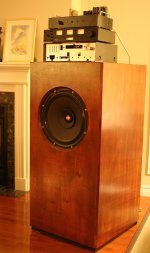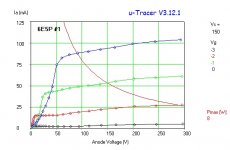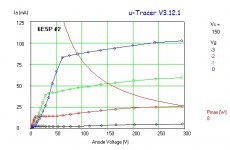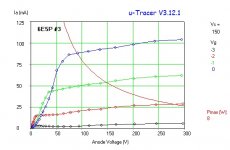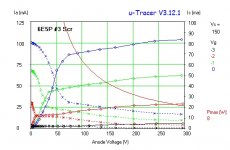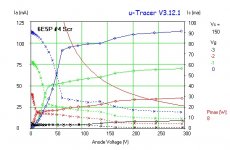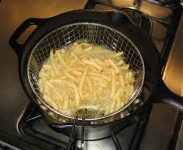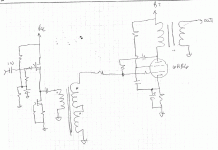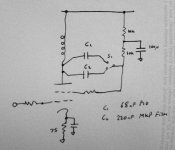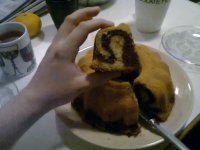Hi Bigun,
I do actually have a utracer, so ashamed that I didn't measure any of these tubes yet 😱 Will have a look if I manage to measure a couple today.
Did you "burn in" your 6E5P? I have had several tubes with low emission, but a couple hours with voltage applied to the heater solved that = emission went up.
will report back!
Erik
I do actually have a utracer, so ashamed that I didn't measure any of these tubes yet 😱 Will have a look if I manage to measure a couple today.
Did you "burn in" your 6E5P? I have had several tubes with low emission, but a couple hours with voltage applied to the heater solved that = emission went up.
will report back!
Erik
Member
Joined 2009
Paid Member
Hi Erik,
I have not burned-in the tube at all, it's probably had less than an hour of use so far. I will power it up again this evening and see if there are any changes over time. I will also check again the heater voltage.
But it may be more at a more linear operating point where I have it now. If emission increases I'll have too much power dissipation.
I have not burned-in the tube at all, it's probably had less than an hour of use so far. I will power it up again this evening and see if there are any changes over time. I will also check again the heater voltage.
But it may be more at a more linear operating point where I have it now. If emission increases I'll have too much power dissipation.
Member
Joined 2009
Paid Member
I checked the heater voltage and it's 6.33Va.c. so no problems there. I let the tube run for a couple of hours and it's rock solid. I thought I'd plug in another tube to see if there's much variation between them. The 2nd tube gives me 1.725V at the cathode, across 47R that's 36.7mA and I get 135V on g2. So this tube runs a bit hotter than the first tube but both seem to be off compared with the data sheet.
Time for a better listening test. I have hooked it up to my Audio Nirvana 15" full range speaker using my Dynalab FM tuner as the source. At this time of night reception is good and I tune in to 89.9 MHz for the best quality - not your average pop and over-compressed sizzle on this channel.
The sound is quite enthralling. Deep bass without any issue, treble is clean without any harshness. The mid range is slightly lean, no tube 'fatness' to it and I'm not sure yet if it's as clean as it should be - trying to judge using FM radio after all. It's not as clean as my gnf solid state power amp. I think there's still some tweaking to do in this regard - I have yet to play with the operating point. PLENTY of volume, my family won't allow me to crank it.
Time for a better listening test. I have hooked it up to my Audio Nirvana 15" full range speaker using my Dynalab FM tuner as the source. At this time of night reception is good and I tune in to 89.9 MHz for the best quality - not your average pop and over-compressed sizzle on this channel.
The sound is quite enthralling. Deep bass without any issue, treble is clean without any harshness. The mid range is slightly lean, no tube 'fatness' to it and I'm not sure yet if it's as clean as it should be - trying to judge using FM radio after all. It's not as clean as my gnf solid state power amp. I think there's still some tweaking to do in this regard - I have yet to play with the operating point. PLENTY of volume, my family won't allow me to crank it.
Attachments
Last edited:
some 6E5P curves
Hi Bigun,
I measured 4 samples of these tubes (tetrode mode) this morning, here they come. The last two are also for sample 3 and 4, but show Screen current as well.
Cheers, Erik
Hi Bigun,
I measured 4 samples of these tubes (tetrode mode) this morning, here they come. The last two are also for sample 3 and 4, but show Screen current as well.
Cheers, Erik
Attachments
Member
Joined 2009
Paid Member
Wow Erik - that's great stuff !
When I look at, say the 2nd chart, I can see that my measurements are not so far off. At around 230V anode with -1.5V or so on g1 the current should be around 30mA to 40mA. Seems that my tubes are operating same way you are measuring.
You have a very handy piece of equipment there !
I did more listening last night. There is something not quite nice about the sound after all. On simple music it is OK, but on pop music it gets tiring. I can hear something that becomes a bit hard in the treble, that makes it sound like a Yukon Gold potato fries sizzling in the oil 🙁
I am wondering if the tetrode mode is not linear enough, if it was poor FM sound - or could there be some oscillations that these high gm tubes are famous for. I will investigate again this evening.
When I look at, say the 2nd chart, I can see that my measurements are not so far off. At around 230V anode with -1.5V or so on g1 the current should be around 30mA to 40mA. Seems that my tubes are operating same way you are measuring.
You have a very handy piece of equipment there !
I did more listening last night. There is something not quite nice about the sound after all. On simple music it is OK, but on pop music it gets tiring. I can hear something that becomes a bit hard in the treble, that makes it sound like a Yukon Gold potato fries sizzling in the oil 🙁
I am wondering if the tetrode mode is not linear enough, if it was poor FM sound - or could there be some oscillations that these high gm tubes are famous for. I will investigate again this evening.
Attachments
Last edited:
Member
Joined 2009
Paid Member
for once a page that don't make me hungry
p.s. I hope you like that image of the chips in the fryer 🙂
but on pop music it gets tiring. I can hear something that becomes a bit hard in the treble
Sounds like IMD, although oscillation is a possibility. Simple music will sound "fuller" with mild THD, since there are few simultaneous sounds. When there are multiple simultaneous sounds there is enough IMD generated to get annoying.
Sometimes the cure is a bit more bias current. You can try this to see if it helps. If your OPT has multiple secondary taps, try your speakers on different taps. Often different tubes will produce different levels of IMD in the same circuit. This is the real reason for "tube rolling".
Place an AM radio near the "spud." Tune it to a weak station, then play some of the offending music through the amp while listening to the AM radio. If the radio suffers interference on the distorted music passages, oscillation IS present. Sometimes oscillation occurs in short bursts. Often it doesn't happen at all when a scope probe is connected to the amp.
Note, some recordings have excessive IMD in them. Metallica's S&M (Symphony and Metallica) is an example. Somebody didn't know how to record or mix that many simultaneous instruments. I haven't found a stereo yet that I can listen to that CD without turning it off.
Last edited:
Here's a possible "Spud with Help" using the 6HB6. This could be put together with all three building blocks (follower, XFMR, 6HB6), with just follower or XFMR and 6HB6, or with the 6HB6 alone. An "Almost Spuddy" (certainly minimal) P-P amp could be put together with a transformer with 2 secondaries driving a pair of the 6HB6.
Nelson Pass used a Jensen JT-11 variant with dual secondaries to drive his complementary SIT amp presented at the 2013 Burning Amp. Here the dual secondaries could be used to eke out a bit more voltage gain if desired.
I have all the bits necessary to try this, but not the time, as I'm busy completing other projects already in the works for the 2015 burning Amp.
Nelson Pass used a Jensen JT-11 variant with dual secondaries to drive his complementary SIT amp presented at the 2013 Burning Amp. Here the dual secondaries could be used to eke out a bit more voltage gain if desired.
I have all the bits necessary to try this, but not the time, as I'm busy completing other projects already in the works for the 2015 burning Amp.
Attachments
Member
Joined 2009
Paid Member
Sounds like IMD, although oscillation is a possibility. Simple music will sound "fuller" with mild THD, since there are few simultaneous sounds. When there are multiple simultaneous sounds there is enough IMD generated to get annoying.
Sometimes the cure is a bit more bias current. ...
Hi George,
I powered up the CRO tonight to check it out - I didn't have an AM radio to hand. No sign of oscillations. I did find a 'dirty' waveform on the heater, nasty spikes at 120Hz repetition which I assume originate from the rectifier on the HT winding causing nasties that feedthrough the power transformer to the heater winding. I soldered in a small cap from the heater to ground near the tube socket and this removed 95% of the nasties.
I looked at the grids on the CRO - nothing nasty. Next to get powered up was the signal generator. Sine waves at the output were smooth clean with no sign of nasties. I was able to clearly see clipping on the output when the input signal exceeded the cathode bias. I decided to give myself more headroom by increasing the cathode bias voltage to 2.4V and I kept the current more or less where it was. I can't increase it without running out of power dissipation headroom - I know you (George) don't worry about such things !!!!!🙂
Square waves produced some very small wiggles after the leading edges of the transitions but no sign that they stirred up anything nasty. The wiggles looked reasonably well damped and they depended on which tap of the OPT I was hooked up to. I had an 8R dummy load connected of course.
Rather than make further changes I decided to hook it back up to some music and make sure that these changes could be 'heard'. The sound does not have that 'muddy' sound I have heard once before from a SS amp that had plenty of harmonic/IM distortion - it's a clean sound. I do think it's improved from yesterday. The issue is that there's some brightness in the treble - perhaps it's a frequency response issue - with a high output impedance could I be getting a treble rise due to the rising impedance of the speaker voice coil ?
Last edited:
Member
Joined 2009
Paid Member
... An "Almost Spuddy" (certainly minimal) P-P amp could be put together with a transformer with 2 secondaries driving a pair of the 6HB6.
I have some Hammond 1:1 c.t. transformers somewhere that would make good phase splitters for a PP 'spud' amp - that could well be the basis of another project.
Member
Joined 2009
Paid Member
Member
Joined 2009
Paid Member
I've been messing around with it again.
1/ Heater: I thought that with me only using it at lower current that I could avoid the power waste with the 6.3V winding and try the 5V winding. Unloaded it measures 5.2V and loaded it's 5.13V. The tube powers up and draws normal current but the cathode is now a dull red instead of a bright red. I'll try it like this for awhile. I'm measuring 2.3V on the cathode, across 75R that's 30mA.
2/ Treble needs some roll-off: I have added a switched capacitor between the anode and g2. It's a kind of feedback, reducing gain and output impedance in the treble. It's a kind of triode-wired-treble.
Listening - the trioded wiring cuts down on the sensitivity, the volume control needs to be at 2/3 instead of 1/3. However, it does work in rolling off the treble to produce a more balanced sound and less harshness all around.
1/ Heater: I thought that with me only using it at lower current that I could avoid the power waste with the 6.3V winding and try the 5V winding. Unloaded it measures 5.2V and loaded it's 5.13V. The tube powers up and draws normal current but the cathode is now a dull red instead of a bright red. I'll try it like this for awhile. I'm measuring 2.3V on the cathode, across 75R that's 30mA.
2/ Treble needs some roll-off: I have added a switched capacitor between the anode and g2. It's a kind of feedback, reducing gain and output impedance in the treble. It's a kind of triode-wired-treble.
Listening - the trioded wiring cuts down on the sensitivity, the volume control needs to be at 2/3 instead of 1/3. However, it does work in rolling off the treble to produce a more balanced sound and less harshness all around.
Attachments
I agree. 50EH5 is fine, as is 35EH5, or for that matter, 12FX5 / 60FX5.
And if you open up to all the 9 pin and Compactron triode/pentode tubes out there, it seems like the world is open to the low-watt spud family.
Member
Joined 2009
Paid Member
How can you 'resist' such a nice cake 🙂
Well, I'm now listening with this new topology, a 220nF cap from anode to screen grid seems to give the best balance. More tweaking still to be tried.
And I should remind that this is strictly point-to-point wired spud amp 😛
Well, I'm now listening with this new topology, a 220nF cap from anode to screen grid seems to give the best balance. More tweaking still to be tried.
And I should remind that this is strictly point-to-point wired spud amp 😛
Attachments
Last edited:
Member
Joined 2009
Paid Member
I'm beginning to think my CHN-70 full range driver is a lemon. Something 'too hot' and a bit of beaming going on. So most listening using Audio Nirvana 15".
I put a variable resistor in the screen grid supply so that I could vary things around a bit. Using this I was able to vary the total cathode current between 24mA and over 30mA. Maybe not a huge range but curious to see if I could hear any difference.
VR1 Vk Vg2 ik
23k 1.92 140 24mA
18k 2.11 147
13k 2.27 155 27.6mA
10k 2.37 159
7k5 2.48 165 30mA
I have to say, I couldn't hear a significant difference, perhaps a bit softer at lower current but nothing significant.
Seems that changing the current isn't sweetening the spud amp, but you can use currants to sweeten some spud fritters 🙂
I put a variable resistor in the screen grid supply so that I could vary things around a bit. Using this I was able to vary the total cathode current between 24mA and over 30mA. Maybe not a huge range but curious to see if I could hear any difference.
VR1 Vk Vg2 ik
23k 1.92 140 24mA
18k 2.11 147
13k 2.27 155 27.6mA
10k 2.37 159
7k5 2.48 165 30mA
I have to say, I couldn't hear a significant difference, perhaps a bit softer at lower current but nothing significant.
Seems that changing the current isn't sweetening the spud amp, but you can use currants to sweeten some spud fritters 🙂
Attachments
Last edited:
- Home
- Amplifiers
- Tubes / Valves
- Yukon Gold - a spud amp
